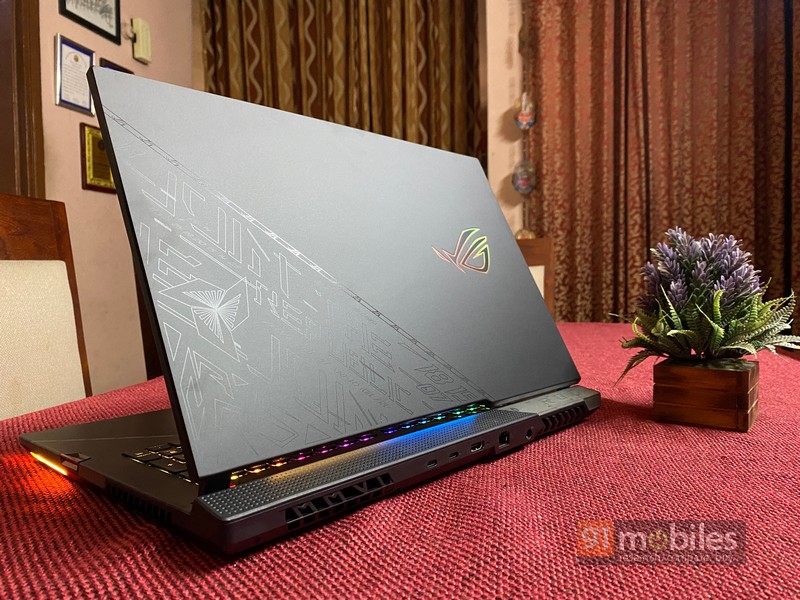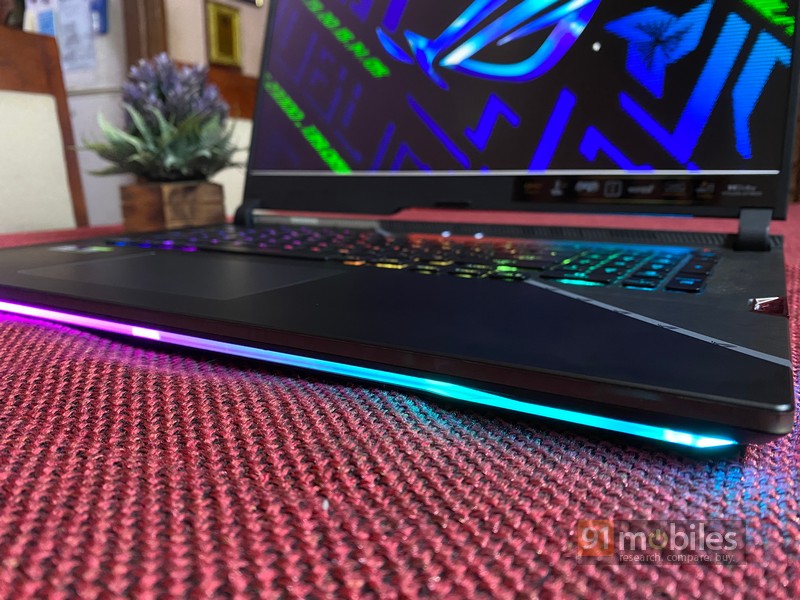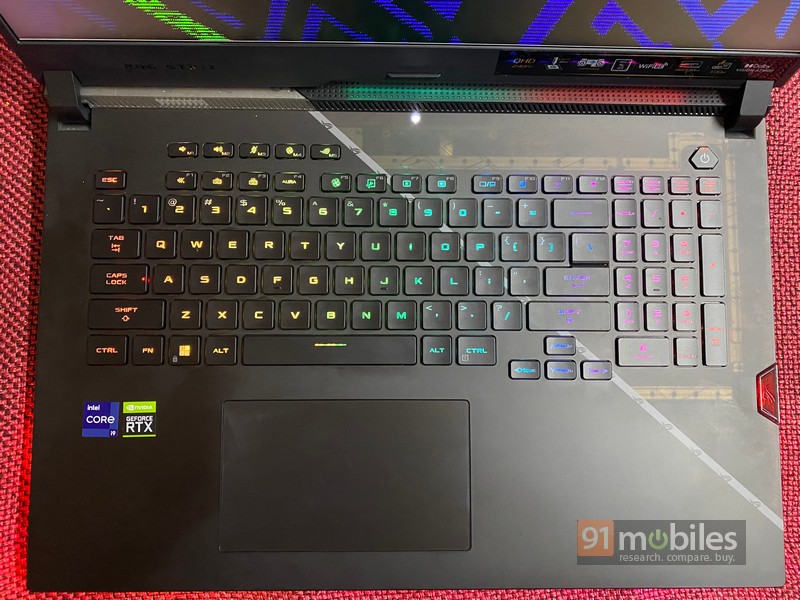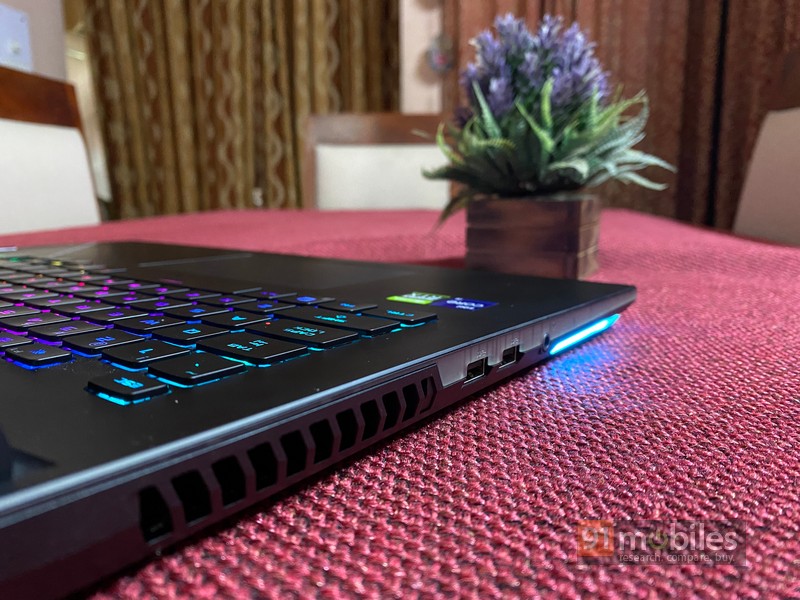ASUS ROG Strix Scar 17 SE review: performance for the ages
I recently got my hands on the ASUS ROG Strix Scar 15 (review) and concluded it to be a serious powerhouse. My review unit carried a hefty price tag of Rs 2,64,990, top-of-the-line specs and was clearly a device meant for enthusiast gamers with deep pockets. The Strix Scar 17 SE, which I have with me now, is exactly the same device but with a larger 17-inch display. It also comes with NVIDIA’s best mobile GPU, and Intel’s top-end CPU, amplifying its position as a performance fiend. The Strix Scar 17 SE is one of the priciest laptops in the market, priced starting at 3,59,990. Let’s find out in this detailed review if it is worthy of your consideration.

The lowdown
- The Strix Scar 17 SE is a sizeable machine and hard to fit inside your everyday backpack. Add to that its massive 330W charging brick and you can be sure that lugging them around can be backache-inducing. However, in case you do want to carry it around, you should know that the overall build quality of the laptop mimics the Scar 15. It is robust, solidly constructed, and has a matte-finished plastic unibody design which weighs just under 3kgs.

- The device has an RGB light strip running alongside the bottom edge that provides a diffused under glow. Even the ROG logo on the lid’s back can be customised with RGB presets via the Armoury crate app. You also have the option of replaceable Armour Caps to change the hinge’s look. A portion of the keyboard is made from a semi-translucent material providing an obfuscated view of the internals housed inside the Strix Scar 17 SE.

- Like the Strix Scar 15, ASUS has provided its proprietary Keystone on the Scar 17 SE. It attaches magnetically and allows you to import lighting settings, game saves, and more with other compatible ROG devices. Unfortunately, there is no webcam on the laptop, which is a bummer in these times of Zoom and Google Meet calls.

- Talking about I/O, the Strix Scar 17 SE has a multitude of ports for hooking up peripherals. On the back, where most of the connectivity options are present, you get a USB 3.2 Type-C port, another USB Type-C with Thunderbolt 4 and DisplayPort support, an HDMI 2.1 slot, and a 2.5G LAN port. The left side houses two USB 3.2 Gen 1 Type-A ports along with a 3.5mm headphone jack while on the right you only have the ROG Keystone slot.
- The display measures 17.3-inches and is of the LCD variety with a 240Hz refresh rate and QHD (2,560 x 1,440) resolution. ASUS is known to provide a stellar viewing experience on its ROG lineup and the Scar 17 SE does not disappoint. The colours and brightness levels are more than optimum for any kind of immersive AAA title. Dolby Vision HDR cranks up the dynamic range and furthers the visual pleasure with compatible OTT content. Also, the 240Hz refresh rate just makes every action from navigation to scrolling buttery smooth. The presence of Adaptive-Sync and a 3ms response time are also key for a tear-free gaming experience.

- The ROG Strix Scar 17 SE has a backlit chiclet-style keyboard with a dedicated numpad on the side. The six-row layout, common with almost all laptops, also has dedicated hotkeys for quick access to the volume controls, microphone, fan speeds and the ASUS Armoury crate. The travel on each is decent enough and the per-key RGB customisation allows you to set different colour themes to specific keys. The backlighting itself is adjustable to three levels and easily visible in low-light conditions. Owing to the chassis’ large size, even with the addition of the Numpad, the keys themselves don’t feel cramped up and provide a comfy typing experience.

- The trackpad is large enough for my liking although the buttons underneath are a bit hard to press. Response and latency were not an issue and I could very well get my office work done without having to indulge in an external peripheral. However, for gaming and productivity needs, I will recommend getting a good gaming mouse.
- In terms of processing, my version of Strix Scar 17 SE is loaded with Intel’s 12th-gen i9 12950HX CPU, the highest-end mobile silicone that the chipmaker has on offer at the moment. The 16-core chipset operates on 24 threads, a TDP of 65W and a maximum clock speed of 5.0GHz. All these specs basically make the Scar 17 SE one of the fastest-performing laptops currently on the market. It stands to reason that nearly all major mobile computing tasks thrown its way will be tackled with ease.
- Add to that 32GB of DDR5 RAM, expandable to 64GB along with 2TB of PCIe 4.0 SSD in RAID 0 configuration, and you can be assured of blazing-fast processing. For some context, the Cinebench R23 benchmark’s multi-core score of 20,281 is the highest I’ve seen on a Windows machine. PCMark 10’s simulation of day-to-day work also outputted a very good score of 7,736. Apart from that, CrystalDiskMark returned some of the best SSD read and write speeds of 9,761.18MB/s and 10,367.31MB/s.
- Thermally the system is very stable, which can be expected from ASUS’ track record with its ROG lineup. The Scar 17 SE uses Thermal Grizzly’s Conductonaut Extreme liquid metal that is claimed to cool down the system by up to 15 degrees as compared to traditional thermal paste.

- Apart from the vapour chamber, there are four exhaust vents that control the airflow across the chassis constantly dissipating heat. The fans are said to operate 15 percent more efficiently with a new anti-dust tunnel design. Basically, the laptop doesn’t get hot or even too loud for that matter. All my tests have been done on the Turbo fan profile which is effective at not letting the CPU or GPU get too warm.
- Moving now to the graphics, NVIDIA has supplied the Strix Scar 17 SE with its highest-end mobile GPU, the RTX 3080 Ti. It has 16GB of VRAM and a TDP of 150W, with an additional 25W supplied through Dynamic Boost. With this CPU, GPU and thermal setup, the laptop can run absolutely any game at the maximum possible graphics. Of course, the laptop also comes with ASUS’ MUX switch functionality which can be enabled in the Armoury Crate app for even better frame rates and power management. Popular titles like Valorant, CS: GO, and Apex Legends can churn out an easy 200fps without a hitch.
- The more intensive AAA games are not far behind with God of War running at QHD resolution, ray-tracing and Ultra graphics 100-110fps, which is the highest I’ve seen till now. CyberPunk 2077, also running at maximum possible specs in terms of resolution, ray-tracing, and graphics, outputs a steady 60-70fps. It does push the GPU’s power usage to 170W and above. The Witcher 3 also ran at 95-110fps while at full display and graphic settings. Lastly, I did run 3DMark’s Time Spy benchmark which again broke previous records with a score of 13,408.

- As for the audio quality, the speaker system on the device is definitely not the best. It’s advisable to use a pair of good headphones for both media consumption and gaming activities. The 90Whr battery housed inside the laptop can only power the internals for about 3 hours while any heavy-duty gaming can drain the cell in little more than an hour. So the 330W bundled charging adapter will have to be carried around wherever the Strix Scar 17 SE goes.
Verdict

The ASUS ROG Strix Scar 17 SE is one of the most powerful laptops for gaming. Yet it lacks a webcam or any kind of biometric authentication. Speakers and battery life are not that great and neither is the device’s portability. However, it has most of the elements that make a sound performance-oriented machine. The gamer aesthetics outside and other aspects easily make it one of the most flamboyant laptops you can buy. One thing that has to be thought thoroughly is whether your gaming needs require you to spend Rs 3,99,990, which is the price of my review unit. There are other very capable machines as well that may not be so processor-intrinsic, but make up for it in other areas. If your goal still remains to get the fastest machine money can buy, then the Strix Scar 17 SE is the laptop to beat.
Editor’s rating: 3.5 / 5
Pros
- Blazingly fast
- Smooth 240Hz QHD panel
- Robust build
- Good thermal design
Cons
- Expensive
- No webcam
- Poor battery life
- Not very portable
The post ASUS ROG Strix Scar 17 SE review: performance for the ages first appeared on 91mobiles.com.
https://ift.tt/v2Ck49L
https://ift.tt/qwpkFiS



No comments